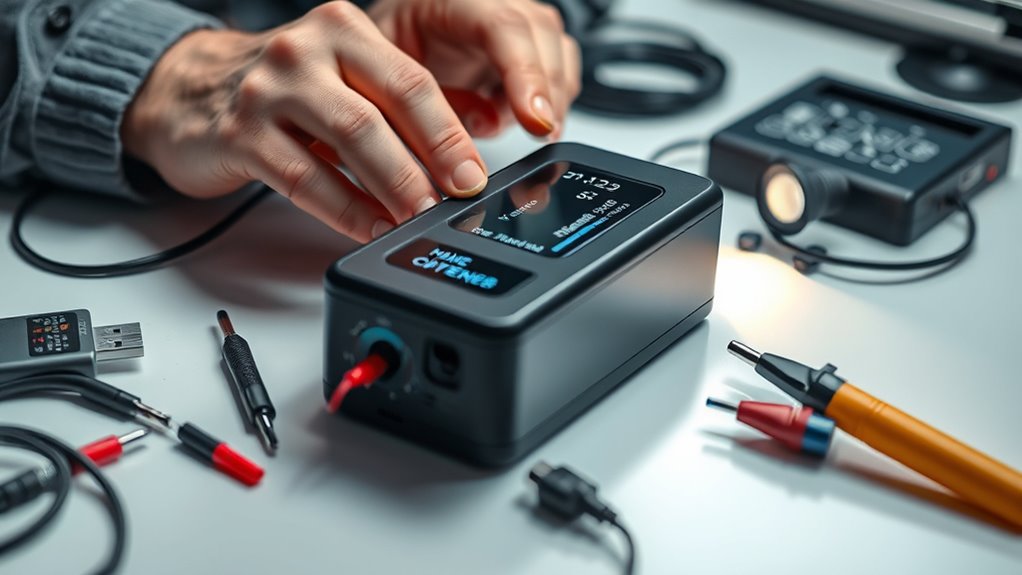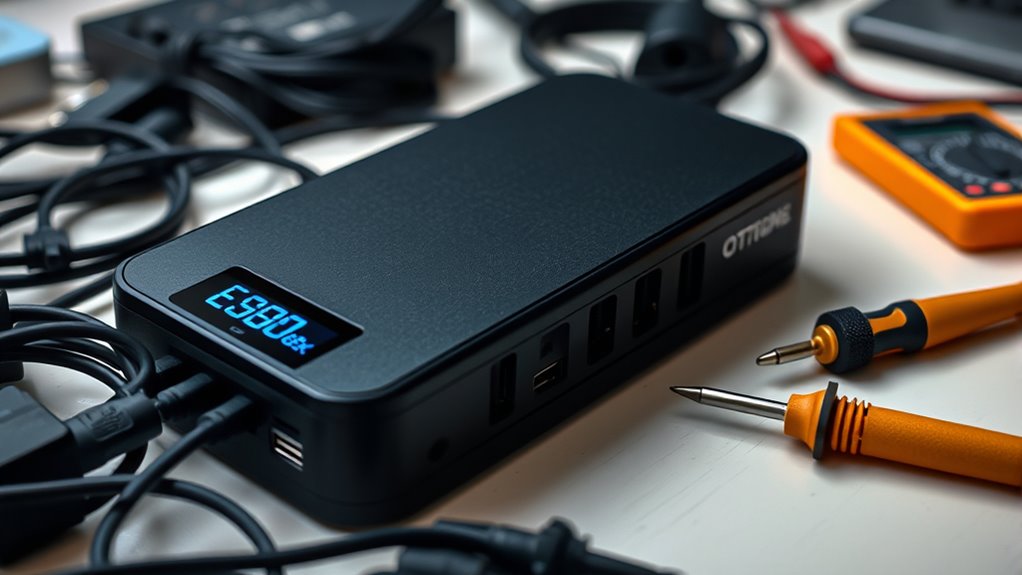To troubleshoot your portable power station, first check if all connections are secure and compatible, especially with solar panels. Make certain solar panels are clean, positioned correctly, and receiving maximum sunlight. Avoid deep discharges and keep the battery charged regularly to prevent capacity loss. If problems persist, consult the user manual or manufacturer’s support for specific instructions. Keepingtrack of these key tips can help solve common issues and ensure your device stays reliable.
Key Takeaways
- Verify solar panel compatibility with the power station’s voltage, current, and connector type before use.
- Ensure solar panels are positioned in direct sunlight with minimal shading and kept clean for optimal efficiency.
- Monitor battery health regularly using the device’s display or app, and avoid deep discharges to prevent capacity loss.
- Check all connections and cables for damage or loose contacts to prevent charging or operation issues.
- Follow manufacturer guidelines for setup, maintenance, and troubleshooting to resolve issues promptly and ensure safe operation.

Portable power stations are a convenient solution for keeping your devices charged on the go, but like any electronic device, they can sometimes encounter issues. One common problem involves charging or recharging the station, especially when you’re relying on solar panels for power. If you’re using solar panel compatibility as a way to recharge your portable power station, it’s essential to verify that your panels are compatible with the station’s input specifications. Not all solar panels work seamlessly with every model, so check the voltage, current, and connector type to guarantee proper compatibility. Using incompatible panels can lead to inefficient charging or even damage your station’s internal components. Additionally, improper setup, such as incorrect angles or shading, can reduce solar input and hinder charging efficiency. To maximize charging from solar, position your panels where they receive maximum sunlight, and clean them regularly to prevent dirt or debris from blocking sunlight. Properly matching your solar panel setup with your power station ensures you get the most out of your solar energy, especially when you need reliable, off-grid power. Regularly inspecting your solar setup can also help identify potential issues early.
Another issue you might face relates to battery capacity enhancement. Over time, the battery inside your portable power station can degrade, impacting its ability to hold a charge. If you notice your station isn’t holding power as long as it used to or drains quickly, it might be time to evaluate the battery’s health. Many models include battery management systems that help enhance battery capacity by preventing overcharging and deep discharges. However, even with these safeguards, frequent deep cycles or leaving the station discharged for extended periods can accelerate capacity loss. To prolong battery longevity, avoid draining the battery completely and keep it charged regularly, especially if you plan to store the station for a while. Some stations allow you to monitor battery health through their apps or display screens, giving you insights into its performance. If the battery’s capacity is greatly diminished and it’s affecting your usage, consider replacing the battery if your model allows it or consulting a technician for professional repair. Proper handling and maintenance can extend the life of your portable power station and keep it functioning at its best.
In addition, selecting a portable power station with a high-quality battery management system can significantly improve overall reliability and lifespan. Ultimately, troubleshooting these issues involves understanding your device’s specifications and maintaining it properly. Confirming solar panel compatibility and enhancing battery capacity are key to maintaining reliable performance. Regularly inspecting your setup, avoiding extreme discharges, and using compatible accessories help prevent many common problems. When issues do arise, addressing them promptly and following manufacturer guidelines will keep your portable power station ready for your next adventure or emergency.
Frequently Asked Questions
Can I Use My Portable Power Station While It’s Charging?
Yes, you can use your portable power station while it’s charging, but you should prioritize charging safety and guarantee your device is compatible with the power station. Check the manufacturer’s guidelines for power station compatibility and avoid overloading it. Using it during charging is convenient, but be cautious of heat buildup and ensure proper ventilation. Always follow safety instructions to prevent damage and maintain ideal performance.
What Should I Do if the Power Station Makes Strange Noises?
Like a vintage radio in a sci-fi movie, strange clicking and unusual noises from your power station signal trouble. If you hear these sounds, stop using it immediately, as battery overheating could be the cause. Check for overheating, and if the noise persists, unplug the device and consult the manufacturer’s troubleshooting guide. Avoid risking damage or fire—safety first. Always prioritize professional assistance when in doubt.
How Do I Reset a Frozen or Unresponsive Power Station?
To reset a frozen or unresponsive power station, start with power button troubleshooting by pressing and holding the power button for about 10-15 seconds. If that doesn’t work, perform a firmware reset if your device allows it—usually through a specific combination of buttons or via the app. This process clears temporary glitches, restoring normal function. Always check your user manual for model-specific reset instructions.
Is It Safe to Leave the Power Station Connected to Devices Long-Term?
It’s generally safe to leave your power station connected to compatible devices long-term, but doing so can affect its battery lifespan. Over time, continuous connection may lead to battery degradation, so it’s best to disconnect devices when not in use. Always check your power station’s manual for device compatibility and recommended usage guidelines to guarantee safe, ideal performance and prolong the device’s lifespan.
How Often Should I Perform Maintenance on My Power Station?
To keep your power station humming smoothly, you should perform maintenance every few months. Follow the storage guidelines, especially if you won’t use it for a while, and consider battery calibration periodically to guarantee accurate performance. Regularly inspecting connections and cleaning vents helps prevent issues. This gentle routine keeps your device reliable, extending its lifespan and ensuring it’s always ready when you need it most.
Conclusion
So, after all that troubleshooting, you might find it amusing how often the simplest fix—like ensuring a proper connection—solves the problem. You set out to conquer complex issues, only to discover that sometimes, the power station just needs a little attention and patience. Ironically, the very device designed to keep you powered up can become a reminder that even the smartest gadgets rely on straightforward care. Embrace the quirks—your station’s quirkiest fix might be just a plug away.









